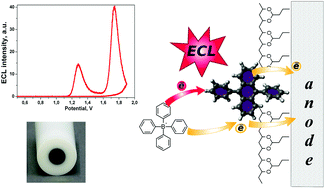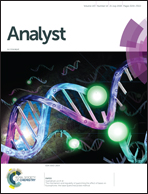Electrogenerated chemiluminescence at a 9,10-diphenylanthracene/polyvinyl butyral film modified electrode with a tetraphenylborate coreactant†
Abstract
A new, efficient electrochemiluminescent (ECL) system based on a 9,10-diphenylanthracene/polyvinyl butyral film modified glassy carbon electrode and a tetraphenylborate anion coreactant is described. The system demonstrates strong dependence of its response on the potential scan rate. In pulsed excitation mode, the system allows for tetraphenylborate detection at a level down to 5 nM with a broad range of linear responses. The anodic cyclic voltammetry response of the system shows 2 distinct ECL waves. It was found that the first of them is due to the reaction of an oxidized fluorophore with tetraphenylborate while the second one is due to the oxidation of tetraphenylborate only. The presented results demonstrate the high potential of the tetraphenylborate coreactant for exciting pulsed ECL in fluorescent species/labels immobilized on the electrode surface, which has application potential for a number of existing ECL assay systems. Due to the ability of tetraphenylborate ions to interact with a number of cations and inorganic oxidants, the developed ECL system can also be applied for quantification based on ECL quenching that was demonstrated on the examples of hydrogen peroxide and hypochlorite.



 Please wait while we load your content...
Please wait while we load your content...